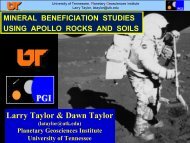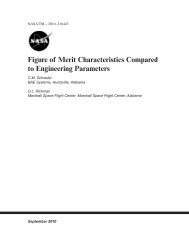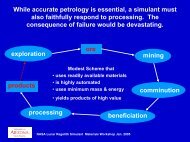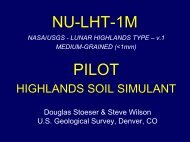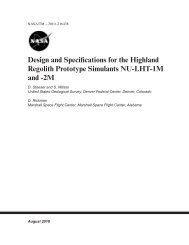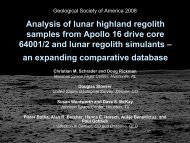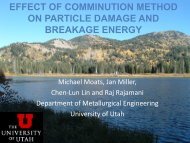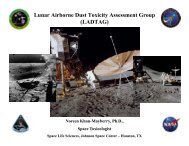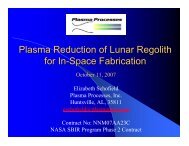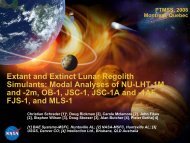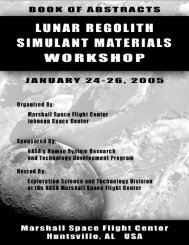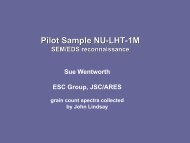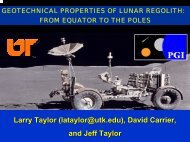Measurement of Particle Size and Shape Distribution For ... - Nasa
Measurement of Particle Size and Shape Distribution For ... - Nasa
Measurement of Particle Size and Shape Distribution For ... - Nasa
You also want an ePaper? Increase the reach of your titles
YUMPU automatically turns print PDFs into web optimized ePapers that Google loves.
SAP #: 10011301<br />
<strong>Measurement</strong> <strong>of</strong> <strong>Particle</strong> <strong>Size</strong> <strong>and</strong> <strong>Shape</strong><br />
<strong>Distribution</strong><br />
<strong>For</strong>:<br />
USGS-NASA<br />
DFC BLDG 20 MS 964<br />
Denver, CO 80225<br />
Contact: Stephen Wilson<br />
Tel: 303-236-1202<br />
e-mail: swilson@usgs.gov<br />
Performed by: Mae Gackstetter, Malvern Inc, 10<br />
Southville Road, Southborough, MA 01772<br />
(mae.gackstetter@malvern.com)<br />
Dates <strong>of</strong> analysis: 3 rd July 2007
Summary<br />
The technique <strong>of</strong> image analysis has been used to characterize the particle size <strong>and</strong><br />
shape distribution <strong>of</strong> Lunar Highl<strong>and</strong>s Type simulant samples supplied by USGS-<br />
NASA. The methodologies, assumptions <strong>and</strong> derived particle size <strong>and</strong> shape<br />
distributions are discussed within this report.
Contents<br />
1. Objectives<br />
2. Background<br />
3. Materials (<strong>and</strong> form) <strong>and</strong> instrumentation<br />
4. Method<br />
5. Assumptions<br />
6. Results<br />
7. Discussion<br />
8. Conclusions
1. Objectives<br />
The objective <strong>of</strong> this study was to provide size <strong>and</strong> shape distribution information on Lunar<br />
Highl<strong>and</strong>s Type simulant samples supplied by USGS-NASA.<br />
2. Background<br />
Two samples were submitted by USGS-NASA for measurement with image analysis techniques<br />
provided by Malvern Instruments Inc. The sample was:<br />
1 Lunar Highl<strong>and</strong>s Type simulant, medium grain size, NU-LHT-1M, 121<br />
2 Lunar Highl<strong>and</strong>s Type simulant, medium grain size, NU-LHT-1M, 026<br />
3. Materials (<strong>and</strong> form) <strong>and</strong> instrumentation<br />
Both samples were grey powders with larger black specks.<br />
Detailed image analysis <strong>of</strong> each sample was performed on the Malvern Instruments Morphologi<br />
G2 running version 5.01 s<strong>of</strong>tware.<br />
4. Method<br />
Image analysis was conducted on the Malvern Morphologi G2.<br />
Both samples were dispersed dry using forced air, which spreads the sample evenly on a glass<br />
plate. The plate with the particles was then scanned <strong>and</strong> a sufficient number <strong>of</strong> particles (~<br />
20000) were counted <strong>and</strong> sized for statistical validity. A wide variety <strong>of</strong> shape parameters can<br />
then be extracted <strong>and</strong> every individual particle has all the information saved along with the actual<br />
image itself.<br />
5. Assumptions<br />
Each lens on the G2 system is calibrated against a NIST-traceable graticule before it is used to<br />
measure the size <strong>of</strong> the particles. <strong>Shape</strong> parameters are calculated in line with the formulae given<br />
on the attachment. It is important to note that a sufficient number <strong>of</strong> particles need to be<br />
examined for statistical validity, especially if a conversion to volume is contemplated where any<br />
errors in the number distribution will scale accordingly (see attached Basic Principles <strong>of</strong> <strong>Particle</strong><br />
<strong>Size</strong> Analysis). The st<strong>and</strong>ard error <strong>of</strong> measurement is proportional to 1/n 0.5 where n is the number<br />
<strong>of</strong> particles. Thus for a st<strong>and</strong>ard error <strong>of</strong> 1% (= 0.01), then a minimum <strong>of</strong> 10000 particles should<br />
be sampled.<br />
6. Results<br />
Circular equivalent diameters based on volume <strong>and</strong> number along with circularity values are<br />
displayed in Tables 6-1 <strong>and</strong> 6-2 for samples 121 <strong>and</strong> 026 respectively. It should be noted that the<br />
Morphologi G2 is a number-based technique <strong>and</strong> volume-based results are derived from the<br />
number-based data.
Table 6-1 <strong>Size</strong> <strong>and</strong> shape results for Lunar Highl<strong>and</strong>s Type simulant, 121.<br />
Table 6-2 <strong>Size</strong> <strong>and</strong> shape results for Lunar Highl<strong>and</strong>s Type simulant, 026.<br />
Plots showing the number <strong>and</strong> volume-based size distributions for the both samples are displayed<br />
in Figures 6-1 through 6-4.
CE Diameter (µm) smoothed over 100 points<br />
0.7<br />
0.6<br />
0.5<br />
0.4<br />
%<br />
0.3<br />
0.2<br />
0.1<br />
0.0<br />
0.1 1 10 100 1000 10000<br />
CE Diameter (µm)<br />
Figure 6-1 Number-based size distribution 121.<br />
Record 3: Lunar Highl<strong>and</strong>s Sim 121<br />
Volume transformation: CE Diameter (µm) smoothed over 100 points<br />
0.6<br />
0.5<br />
0.4<br />
%<br />
0.3<br />
0.2<br />
0.1<br />
0.0<br />
0.1 1 10 100 1000 10000<br />
CE Diameter (µm)<br />
Record 3: Lunar Highl<strong>and</strong>s Sim 121<br />
Figure 6-2 Volume-based particle size distribution for 121.
CE Diameter (µm) smoothed over 100 points<br />
0.7<br />
0.6<br />
0.5<br />
0.4<br />
%<br />
0.3<br />
0.2<br />
0.1<br />
0.0<br />
0.1 1 10 100 1000 10000<br />
CE Diameter (µm)<br />
Record 4: Lunar Highl<strong>and</strong>s Sim 026<br />
Figure 6-3 Number-based particle size distribution for 026.<br />
Volume transformation: CE Diameter (µm) smoothed over 30 points<br />
0.30<br />
0.25<br />
0.20<br />
%<br />
0.15<br />
0.10<br />
0.05<br />
0.00<br />
0.1 1 10 100 1000 10000<br />
CE Diameter (µm)<br />
Record 4: Lunar Highl<strong>and</strong>s Sim 026<br />
Figure 6-4 Volume-based particle size distribution for 026.<br />
Number <strong>and</strong> volume-based size distributions will generally differ as separate parameters are<br />
being used to determine the size (See attached Basic Principles <strong>of</strong> <strong>Particle</strong> <strong>Size</strong> Analysis). The<br />
number distribution tends to be more sensitive to small particles, while the volume-based<br />
distribution is more sensitive to larger particles that contribute more volume. The spikes in the<br />
high end <strong>of</strong> the volume distribution, especially for 026, are a result <strong>of</strong> a small number <strong>of</strong> large<br />
particles, which have a significant impact on the volume-based distribution. From the tables <strong>and</strong><br />
two above, it appears that on a number-basis, there are more small particles in both samples,
which is to be expected. The noise at the bottom end <strong>of</strong> the number distribution is caused by the<br />
visible light cut <strong>of</strong>f <strong>and</strong> the resolution limit.<br />
The Morpholgi G2 provides several shape distributions for each sample. Plots for some <strong>of</strong> the<br />
most commonly used shape parameters are shown below for each sample. Figures 6-5 shows an<br />
overplot circularity distributions for 121 <strong>and</strong> 026.<br />
HS Circularity smoothed over 30 points<br />
0.9<br />
0.8<br />
0.7<br />
0.6<br />
0.5<br />
%<br />
0.4<br />
0.3<br />
0.2<br />
0.1<br />
0.0<br />
0.0 0.1 0.2 0.3 0.4 0.5 0.6 0.7 0.8 0.9 1.0 1.1<br />
HS Circularity<br />
Record 3: Lunar Highl<strong>and</strong>s Sim 121 Record 4: Lunar Highl<strong>and</strong>s Sim 026<br />
Figure 6-5 HS Circularity distribution for 121 (red) <strong>and</strong> 026 (green).<br />
Sample 026 shows a larger proportion <strong>of</strong> lower circularity material than 121, although the bulk<br />
<strong>of</strong> the material has a HS circularity around 0.9. Figure 6-6 show aspect ratio distributions for 121<br />
<strong>and</strong> 026. Here again, 026 shows more material with a lower aspect ratio.
Aspect Ratio smoothed over 50 points<br />
0.5<br />
0.4<br />
0.3<br />
%<br />
0.2<br />
0.1<br />
0.0<br />
0.0 0.1 0.2 0.3 0.4 0.5 0.6 0.7 0.8 0.9 1.0 1.1<br />
Aspect Ratio<br />
Record 3: Lunar Highl<strong>and</strong>s Sim 121 Record 4: Lunar Highl<strong>and</strong>s Sim 026<br />
Figure 6-6 Plot <strong>of</strong> aspect ratio distribution for 121 (red) <strong>and</strong> 026 (green).<br />
Figures 6-7 shows elongation distributions for 121 <strong>and</strong> 026.<br />
Elongation smoothed over 50 points<br />
0.5<br />
0.4<br />
0.3<br />
%<br />
0.2<br />
0.1<br />
0.0<br />
0.0 0.1 0.2 0.3 0.4 0.5 0.6 0.7 0.8 0.9 1.0 1.1<br />
Elongation<br />
Record 3: Lunar Highl<strong>and</strong>s Sim 121 Record 4: Lunar Highl<strong>and</strong>s Sim 026<br />
Figure 6-7 Elongation distribution for 121 (red) <strong>and</strong> 026 (green).<br />
Only a few <strong>of</strong> the shape distributions measured by the instrument are shown above. It is possible<br />
to display many other shape factors.<br />
The Morphologi G2 also stores all the particle images captured <strong>and</strong> used for the analyses. These<br />
images can be viewed using several sorting routines. A selection <strong>of</strong> these images appears below.
Figure 6-8 Images <strong>of</strong> single particles from 121.<br />
Figure 6-9 Images <strong>of</strong> particles from 026.<br />
The instrument also provides detailed information about each particle analyzed as show below<br />
for both samples.
Figure 6-10 Detailed information on single particles from 121 (right) <strong>and</strong> 026 (left).<br />
7. Discussion<br />
Simultaneous size <strong>and</strong> shape measurements are possible using the Morphologi G2, along with<br />
detailed size <strong>and</strong> shape information on every particle. Although the size distributions are quite<br />
similar for the two samples, shape distributions (such as HS circularity <strong>and</strong> aspect ratio) do show<br />
some differences. It may be that the differences we observe are simply sampling artefacts <strong>and</strong> the<br />
reader is referred to the attached application note on sampling.<br />
It should be noted here that different techniques provide different information. If a size<br />
distribution is the primary goal, then laser diffraction is the most appropriate technique.<br />
However, a diffraction measurement does not provide particle shape information, which is easily<br />
obtained with an image analysis technique (i.e. the Morphologi G2). It is important to distinguish<br />
particle shape from the texture or surface morphology <strong>of</strong> a particle. The latter is best obtained<br />
with electron microscopy or a similar technique.<br />
8. Conclusions<br />
The sample was successfully measured after dry dispersion using the Morphologi G2.
Attached: Basic Principles <strong>of</strong> <strong>Particle</strong> <strong>Size</strong> Analysis<br />
Morphologi G2 Parameters<br />
Sampling Application Note<br />
Mae Gackstetter<br />
Malvern Instruments Inc<br />
11 th July 2007



